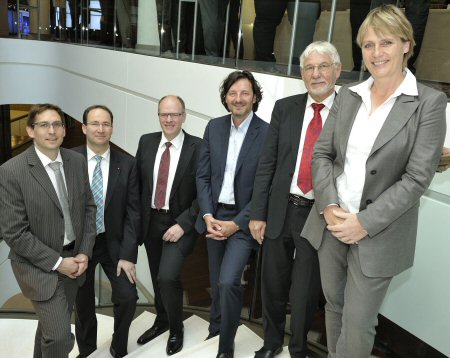That was the name of our event in Berlin. 180 people from reputable companies came to experience Jutta Kleinschmidt, Prof. Gerhard Roth, Bechtle, Leica, Porsche as well as our own ideas live in person. So what did rally racing, brain research, and Business Intelligence have in common that day?
Business Intelligence has made an impact when people turn insights into actions. That, however, is just the final stretch in a long process – and those last few meters will determine if all of the time spent collecting, saving and preparing data was worth the effort (or not). The factors that drive human actions are complex. Emotions play an important role, but motivation even more so. In order for Business Intelligence to have the desired effect, all of these factors must be well understood. With this message, we embarked on an exciting day full of fresh insights with a focus on perception, effects, and willpower.

At the end of a good day for Business Intelligence: Matthias Kauffmann (Porsche AG), Volker Hagemann (Leica Camera AG), Uli Drautz (Bechtle AG), Dr. Nicolas Bissantz, Professor Dr. Dr. Gerhard Roth, and Jutta Kleinschmidt.
Human will has the power to move mountains. Jutta Kleinschmidt has even moved the deserts between them. Her career is unprecedented. As we quickly learned in the ballroom of the Waldorf Astoria, she attributes her success to two factors: an untamable spirit for adventure and virtues that we also know from financial controlling. She loves difficult situations: „With the right planning and method, I can beat my competitors who use a less systematic approach – and, surprisingly, there are many of them.“ She was the first person who brought maps and satellite pictures to the Rally Dakar to supplement the rather crude roadbook that the event’s organizers supply the night before the next stage of the race.
We stayed on the topic of speed for a moment. Matthias Kauffmann, who is responsible for volume planning at Porsche AG, described the relationship between transparency and willpower as such: “When you have transparent data, the next step is clear.” Porsche loves micromanagement. Even on the executive level, everyone knows everything about its noble products – down to every, single vehicle. And they know the customer just as well. No one in the audience was surprised to see that the innovative automobile manufacturer already uses the innovative controlling tools that we presented in the foyer.
Professor Gerhard Roth reported on our work together. The audience could feel the brain researcher’s fascination for the world of business – as well as ours for that of the human brain. The fact that we often react like our baboonish ancestors has both advantages and disadvantages for Business Intelligence. There are many things that people already know because human actions are not as individual as one may believe. We can deal with that – and use the common traits in perception, understanding, and motivation to construct software. It also brings challenges as well – such as the fact that we also experience our environment like a bunch of apes and need to direct people’s attention using the same basic methods that were required in our prehistoric lives on the steppe.

The greatest emotions occur when the message creates an effect and people feel that they have been understood. We succeededed in Berlin. In 2015, we’ll be back.
Sight and perception were also topics in the presentation of Volker Hagemann from Leica Camera. The controller often designed his reports with the same passion and eye for detail that he uses as an amateur photographer. His virtuosic presentation used all of the possibilities to fluently combine overviews with details, without ever losing the audience along the way. So much power over data is very emotional – and effective as well. We are a bit proud that our products, as Hagemann reported, have given the company the necessary insights to act during the difficult phases of its corporate history.
Uli Drautz, the deputy chairman of the supervisory board and director of controlling at Bechtle AG, was a crowd pleaser for the second time at our executive event. He frankly reported on our creative battle to create the best report formats for Bechtle. Before management information does have an emotional effect, it first needs passion, determination, and persistence. That can even heat up discussions dealing with objective numbers. The results were worth the effort: Together, we have created standards for report formats that have flowed back into our software and now are available for our other customers as well.
My phenomenal colleague Dr. Gerald Butterwegge provided an inside look into our R&D. We have a new passion for moving data as an effective way to direct attention. One highlight of the day was a demonstration of how graphic elements can take on human traits through movement. Can management information get more emotional than that?
